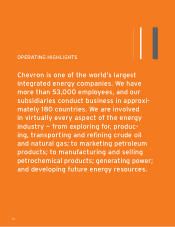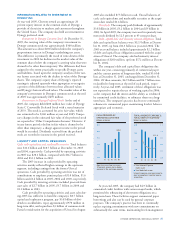Chevron 2005 Annual Report Download - page 30
Download and view the complete annual report
Please find page 30 of the 2005 Chevron annual report below. You can navigate through the pages in the report by either clicking on the pages listed below, or by using the keyword search tool below to find specific information within the annual report.
MANAGEMENT’S DISCUSSION AND ANALYSIS OF
FINANCIAL CONDITION AND RESULTS OF OPERATIONS
28 CHEVRON CORPORATION 2005 ANNUAL REPORT
gas, Chevron is planning increased investments in long-term
projects in areas of excess supply to install infrastructure
to produce and liquefy natural gas for transport by tanker,
along with investments and commitments to regasify the
product in markets where demand is strong and supplies are
not as plentiful. Due to the signifi cance of the overall invest-
ment in these long-term projects, the natural gas sales prices
in the areas of excess supply (before the natural gas is trans-
ferred to a company-owned or third-party processing facility)
are expected to remain well below sales prices for natural gas
that is produced much nearer to areas of high demand and
that can be transported in existing natural gas pipeline net-
works (as in the United States).
Longer-term trends in earnings for the upstream
segment are also a function of other factors besides price fl uc-
tuations, including changes in the company’s crude oil and
natural gas production levels and the company’s ability to
fi nd or acquire and effi ciently produce crude oil and natural
gas reserves. Most of the company’s overall capital investment
is in its upstream businesses, particularly outside the United
States. Investments in upstream projects generally are made
well in advance of the start of the associated crude oil and
natural gas production.
Chevron’s worldwide net oil-equivalent production of
approximately 2.5 million barrels per day in 2005, including
volumes produced from oil sands and production under an
operating service agreement, remained essentially unchanged
from 2004. However, production in the fourth quarter 2005
was nearly 2.7 million barrels per day, refl ecting the benefi t
of volumes associated with the properties acquired from
Unocal, the effect of which was partially offset by production
shut in as a result of the hurricanes in the Gulf of Mexico.
Prior to the hurricanes in August and September 2005,
oil-equivalent production in the Gulf of Mexico was approxi-
mately 300,000 barrels per day. In 2006, production is
projected to average approximately 200,000 barrels per day,
as normal fi eld declines are expected to exceed the produc-
tion being restored from wells that were shut in or damaged
from the hurricanes and the production that will result from
the drilling of new wells in the area. Approximately 20,000
net oil-equivalent barrels of daily production are not expected
to be suffi ciently economic to restore.
The company estimates that oil-equivalent production
in 2006 will average between 2.7 million and 2.8 million
barrels per day. However, future estimates are subject to
many uncertainties, including quotas that may be imposed
by OPEC, the price effect on production volumes calculated
under cost-recovery and variable-royalty provisions of certain
contracts, severe weather, and the potential for local civil
unrest and changing geopolitics that could cause production
disruptions. Approximately 26 percent of the company’s net
oil-equivalent production in 2005, including net barrels from
oil sands and production under an operating service agree-
ment, occurred in the OPEC-member countries of Indonesia,
Nigeria and Venezuela and in the Partitioned Neutral Zone
between Saudi Arabia and Kuwait. Although the company’s
production level during 2005 was not constrained in these
areas by OPEC quotas, future production could be affected
by OPEC-imposed limitations. Future production levels also
are affected by the size and number of economic investment
opportunities and, for new large-scale projects, the time lag
between initial exploration and the beginning of production.
Refer to pages 29 through 30 for discussion of the company’s
major upstream projects.
In certain onshore areas of Nigeria, approximately 45,000
barrels per day of the company’s net production capacity was
shut in during 2003 because of civil unrest and damage to
production facilities. The company has adopted a phased plan
to restore these operations, and about one-third of the vol-
umes had been returned to production as of early 2006.
Refer to pages 31 through 33 for additional discussion
of the company’s upstream operations.
Downstream Refi ning, marketing and transportation
earnings are closely tied to global and regional supply and
demand for refi ned products and the associated effects on
industry refi ning and marketing margins. The company’s
core marketing areas are the West Coast of North America,
the U.S. Gulf Coast, Latin America, Asia and sub-Saharan
Africa. In 2005, industry refi ning margins improved over
the prior year, refl ecting strong demand for refi ned products;
however, marketing margins, which are highly infl uenced
by regional market conditions, were mixed. Many regions
experienced stronger marketing margins, but these margins
were generally lower in the United States and Europe, as
retail prices did not keep pace with rising crude oil and spot
product prices. Industry margins in the future may be vola-
tile, due primarily to changes in the price of crude oil used
for refi nery feedstock, disruptions at refi neries resulting from
maintenance programs and mishaps and levels of inventory
and demand for refi ned products.
Other infl uences on the company’s profi tability in this
segment include the operating effi ciencies and expenses of the
refi nery network, including the effects of any downtime due
to planned and unplanned maintenance, refi nery upgrade
projects and operating incidents. The level of operating
expenses for the downstream segment can also be affected
by the volatility of charter expenses for the company’s ship-
ping operations, which are driven by the industry’s demand
for crude oil and product tankers. Other factors affecting
the company’s downstream profi tability that are beyond the
company’s control include the general level of infl ation and
energy costs to operate the refi nery network.
























